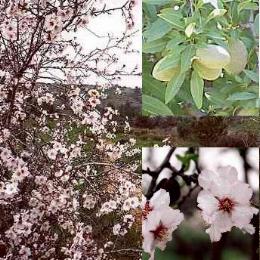
|
|
Almond
(Prunus amygdalus - Amygdalus communis)
|
Almond (Prunus amygdalus - Amygdalus
communis)
The almond (Prunus amygdalus - Amygdalus
communis) is most closely related to the peach, falling into the Prunoideae subfamily of the
Rosaceae. Almond and peach are found in the Amygdalus subgenus within
Prunus.
The tree is of moderate size, usually from
6 to 9 m. high, with
spreading branches the leaves lance-shaped, finely toothed (or
serrated) at the edges. The flowers are produced before the leaves -
from January to March depending of the region - and in great profusion. There are two
principal forms of the Almond the one with entirely pink flowers, Amygdalus
communis, var. dulcis, producing Sweet Almonds; the other, A.
communis, var. amara, with flowers slightly larger, and the
petals almost white towards the tips, deepening into rose at the base,
producing Bitter Almonds.
The almond originated in the hot, dry climate of middle east
(Iran), and spread along the shores of the Mediterranean in northern Africa and southern Europe by
Egyptians, Greeks, and Romans.
Cato himself brought the almond from Greece into Italy. From there,
cultivation spread to north Africa, Spain, Portugal, and France. In
fact, in 812 AD Charlemagne ordered almond trees to be planted in his
imperial orchards. Medieval Europe loved them fresh and green for
their "milk"--which people used instead of cow's milk to get
around holy strictures on Christian fasting days. It was
very early introduced into England, probably by the Romans, and occurs
in the Anglo-Saxon lists of plants, but was not cultivated in England
before 1562, and then chiefly for its blossom. The almond was brought to California in the 1700s by Spanish Padres who settled the Mission at Santa
Barbara. Larger plantings did not occur until the mid-1800s.
The tree grows freely in Syria and
Palestine: it is mentioned in
Scripture as one of the best fruit trees of the land of Canaan, and
there are many other biblical references to it. Almonds, as well as the oil pressed from
them, were well known in
Greece and Italy long before the Christian era. A beautiful fable in
Greek mythology is associated with the tree.
Phyllis, a beautiful princess, was left waiting at the altar on her wedding day by her
intended, Demophon. Phyllis waited for years for him to return, but finally died of a broken
heart. In sympathy, the gods transformed Phyllis into an almond tree, which became a symbol of
hope. When the errant, remorseful Demonphon returned to find Phyllis as a
leafless, flowerless tree, he embraced the tree. The tree suddenly burst into
bloom, a demonstration of love not conquered by death.
Interesting how different cultures interpreted the trees habit of
flowering before leafing. Biblical Hebrews thus regarded the almond as
a symbol of haste because of its sudden blossoming. Thophrastus in
Ancient Greece was content to record the phenomenon. Moslems
associated saw these almond blossoms as a symbol of hope bursting out. Ancient Pagans thought almonds symbolized
virginity. Some even used almonds as an emblem of the Virgin Mary. While symbolising
virginity, almonds were also used as fertility charms and marriage
blessings. Modern Czechs, Italians, and Greeks see them as good luck and long
life--and give out the nuts at weddings.
Source:
http://www.soupsong.com/fnuts.html
http://www.uga.edu/fruit/almond.htm
http://www.botanical.com/botanical/mgmh/a/almon026.html
